First day of March and I went out for a walk by the Bideford Brook where it leaves the Forest hills at Blakeney. A cold north-easterly was blowing and, well wrapped up as I was, winter seemed reluctant to depart. The brook was running at a dirty-grey half flood level, and in any case, this being a Severn tributary, there would be no fishing here until the season starts on the 18th. On the other hand the Wye and Usk open on the 3rd, so I was thinking that a dry period now and the chance for the floods to run off would be appreciated. I had been waiting a long enough time without a rod in my hand. Meanwhile, although I could not see a sign of a single new leaf on this raw day, the daffodils were out shaking in the cold wind and the rooks were quarrelling as they built their nests in bare branches across the field. Spring, after all, could not be far away and I began to consider more optimistically the approach of a new season in the Usk valley, the time of flowers and fresh green shoots, altogether one of the loveliest and most hopeful phases in the fishing calendar. Would the sun shine for a moment, would the fly emerge and would the trout begin to rise again after the long winter? Usually at some time during an early season day spent on the Usk, even while the Beacon peaks are still white with snow, the little miracle repeats itself.
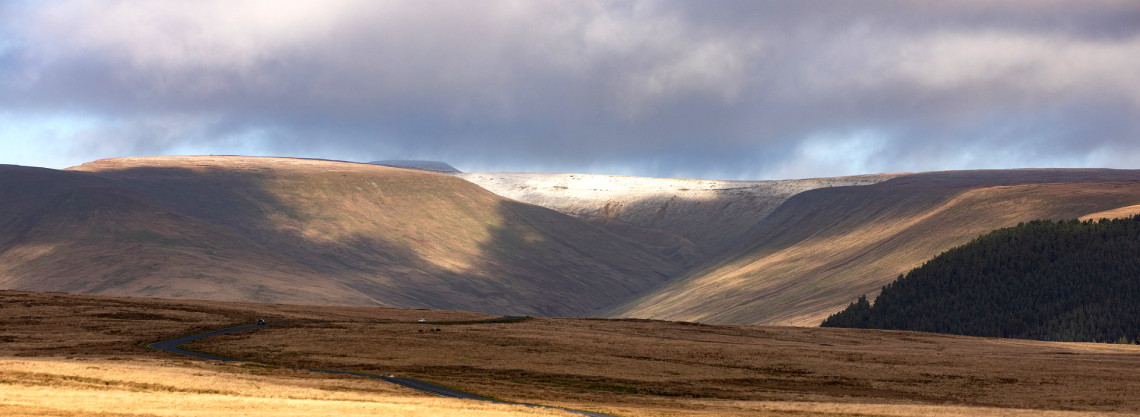
At times like these when our rivers are high and more bands of rain keep blowing in from the Western Ocean, I try to stay flexible. It’s necessary to keep watching the gauges. On 2nd March I thought I saw a chance for a last hurrah with the grayling trotting rod, the Irfon then being down to about 0.65 on the Cilmery gauge. Unfortunately the potential client couldn’t make it, so instead I got on with my spring cleaning and decorating indoors, feeling a bit like Kenneth Grahame’s mole at the beginning of The Wind in the Willows. It was raining again outside anyway.
Meanwhile the barbel fishermen as always impressed me with their willingness to fish through a flood, and a few good barbel and chub were in fact taken on the middle Wye in the last days of their season. This success presumably indicated that the water was not too cold. GK from Bentley had three chub to 4 pounds 7 ounces from Foy Bridge on 1st March, the best fish being photographed alongside a packet of Highland Shortbread. I take it that was for an indication of scale rather than the bait used? I was reminded by that packet of a summer day and a picnic lunch David Burren and I had by the Turbine Pool on the Wiltshire Avon a few years ago. Wherever anglers, or ordinary folk for that matter, are in the habit of eating lunch by the river, some big fish are usually in attendance. David got to flicking in bits of his shortbread to see the monsters coming up through 8 feet of turbulent water, while I’m afraid after wrestling with my conscience briefly I took to flicking in a light coloured Hair Wing Sedge to the same area as a suitable shortbread imitation. I have to admit that it all worked quite well. Shameful behaviour on a chalk stream! Alas for human failings! We did subsequently confess to the keeper and the trout were of course returned. Anyway, GK from Bentley was back at Foy Bridge on the 3rd and got a personal best chub of 5 pounds 11 ounces, this time on Mother’s Pride. I imagine he will find that weight difficult to better while fishing his local River Wey in Hampshire.
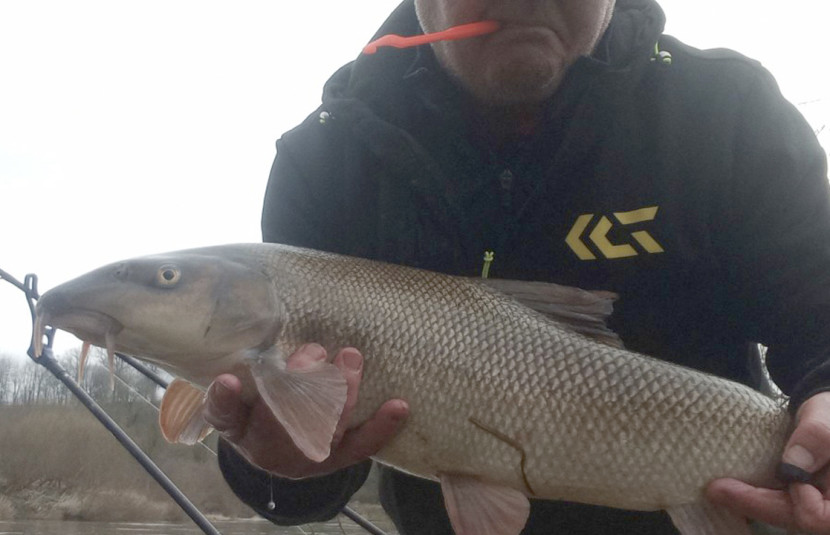 Fownhope barbel for GS from Hemel Hempstead
Fownhope barbel for GS from Hemel Hempstead 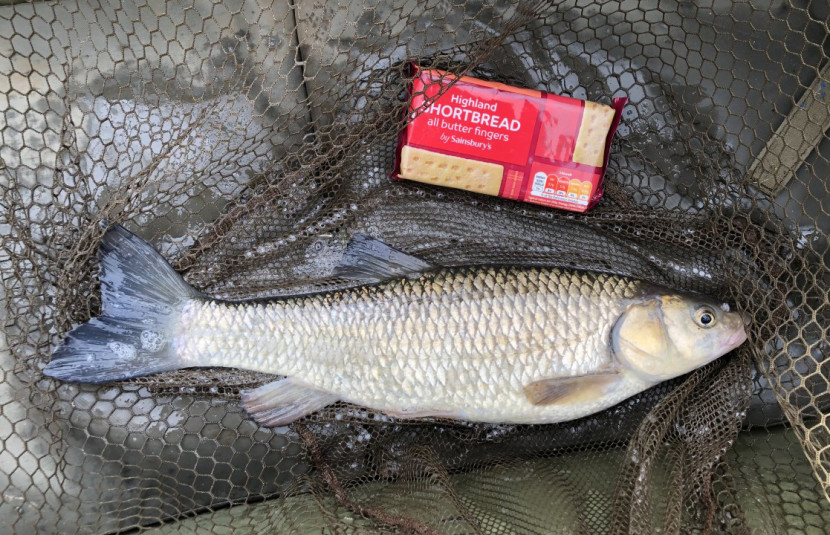 Foy Bridge chub for GK from Bentley
Foy Bridge chub for GK from Bentley The first game fisher to score in the new season was JC from Penarth who while fishing the Usk at Abercynrig found quite a few trout rising in slow water to a hatch of spring olives and something “very small and white.” Given that it was early March and not too warm at that, I’m not too sure what would have been, unless perhaps a hatch of small winter midges. At any rate, a size 18 Grey Duster worked well enough and he netted 3 and lost a few more. The river was clear, but running pretty high, and the following day rain brought the level higher still. Still AL from London with a companion managed 20 trout on dries and spiders from the neighbouring Dinas beat while some large dark olives were hatching.
They were on Abercynrig the following day and managed 7 more trout while a few March browns were now hatching along with the olives. PD from Cheltenham was fishing on Penpont, where unfortunately he broke his rod, and queried whether two large groups of canoeists encountered were trespassing or not? I’m pretty sure they were, because while the water level was high it certainly wasn’t up to the red marker on the gauge which permits canoeing according to agreements. Outside the agreements, there is no right of navigation on the Usk. I hope we aren’t going to have trouble with selfish trespassers splashing through our non-navigable waters all through this summer, but I fear we probably will.
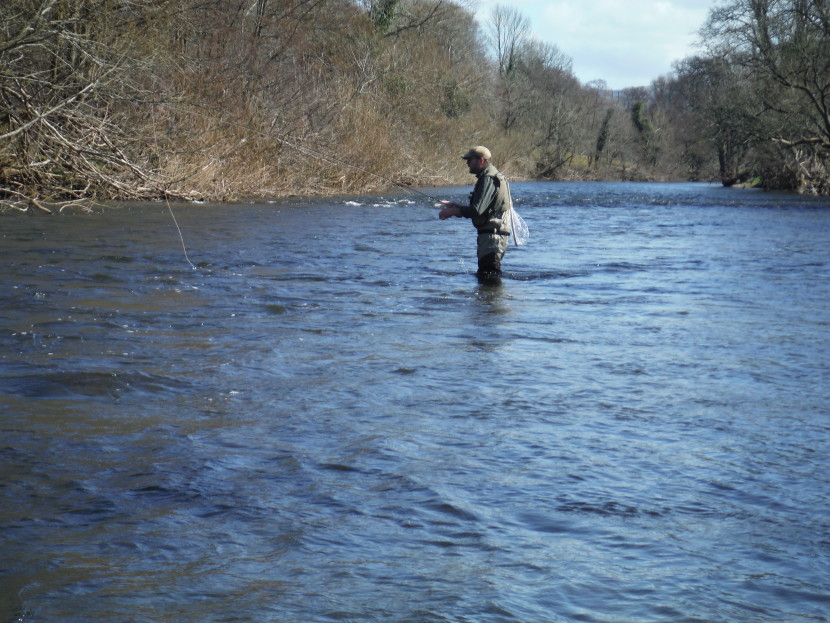 Abercynrig
Abercynrig 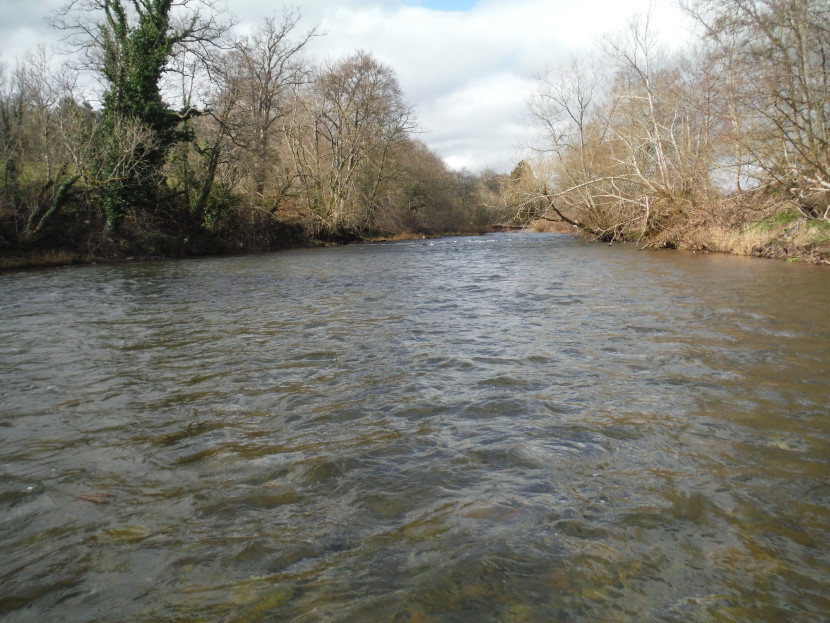 Early March at Brecon
Early March at Brecon On the 7th NB from Reading extracted 6 trout from the Wye at Craig Lyn on spiders and nymphs. That makes for an early start by the standards of Wye trout fishing; the Usk is generally the first to produce results. The days were quite cold at this time with bitter winds from the east, a kind of chill never felt more than while wading in a wide open pool, but by now trout in the Brecon area were coming up to spiders and olives were hatching around the midday period. It’s worth mentioning that if you actually see the duns being taken, a dry fly will probably work. But if there is plenty of natural fly around in the air and on a nice fast section of poppled water, the birds are diving but you see no more than splashes from the river, it may simply be that the trout are chasing the emerging nymphs up from the bottom and taking them just before they reach the top. In which case you might do better with a team of spiders fished across the stream just sub-surface. On a couple of days this spring I found myself fishing with a full team of three Waterhen Bloas and all positions on the leader were provoking takes.
Also on the 7th, Dave Roberts using a Flying C took a fine 3 sea winter salmon of 24 pounds from Caemawr on the middle Wye. That is exactly as it should be for an early Wye salmon and made a fine start to the season. I got a good look at a heavy salmon moving up the Usk above Abergavenny about the same time. With both rivers high, but running down clear, despite the cold winds there seemed to be reason for optimism.
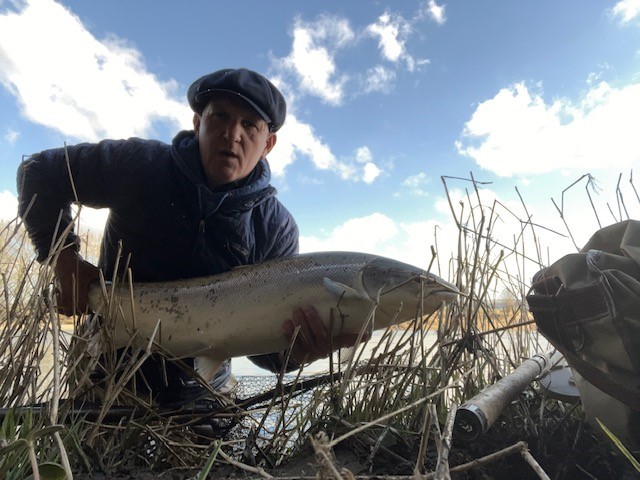 First Wye salmon of the year from Caemwr for Dave Roberts
First Wye salmon of the year from Caemwr for Dave Roberts 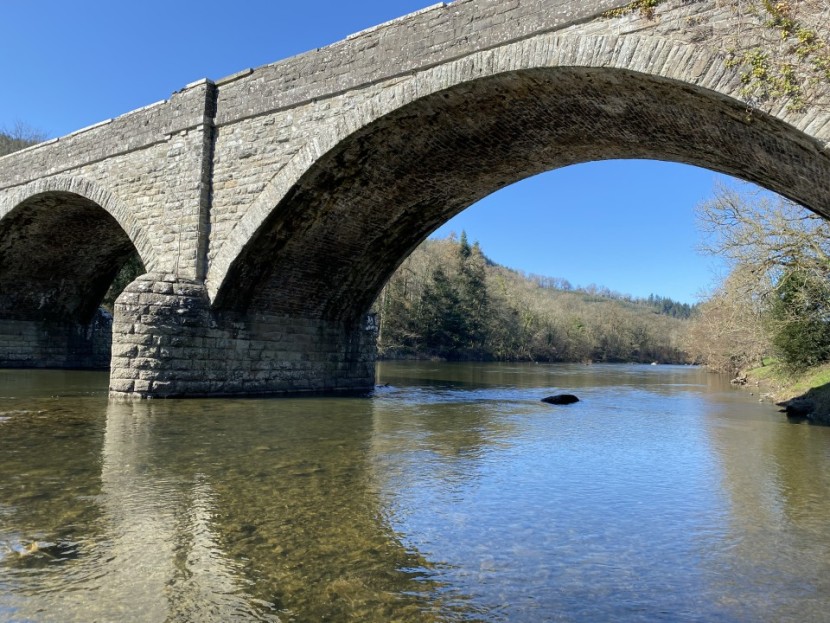 The Rectory Bridge - GB from Harpenden
The Rectory Bridge - GB from Harpenden MH from Swansea, a syndicate member on Llangoed and Lower Llanstephan, also fished for salmon on the 8th. He was unsuccessful with the bigger fish, but fine trout of 15 and 16 inches took his copper Red Devil tube fly. We waited then for salmon number two, but nothing happened until the 10th when Brian Skinner of Brecon hooked for a couple of minutes and then lost a fish of about 10 pounds while spinning the Mill Pool at the Rectory. With barbless hooks, I’m sure we are going to see a few such losses this year.
Seth Johnson-Marshall of the Foundation fished the Middle Usk and encountered a particularly good large dark olive and March brown hatch lasting about 30 minutes, during which he took 4 trout on the dry fly, two of them weighing 1.75 pounds each. Next day we were hit by heavy rain and the rivers went up again, the Wye in particular attaining a very dirty colour. The Beacons reservoirs were being fished now and MW from Neath had half a dozen trout from the Usk Reservoir. JE from Houghton-on-the-Hill managed 4 trout in high water from the Usk at Abercynrig using streamers. On the 13th MH from Swansea was wrong-footed by the loss of the Llanstephan camera gauge which was knocked over by floating debris earlier in this series of floods and thus he arrived at the Rectory to find the water impossibly high. He asked for the repair of the gauge to be prioritised – which will be done as soon as the location can be accessed safely – but it’s worth mentioning that there is an EA/NRW gauge at Llanstephan and it pays to study and get on terms with the EA system also. There’s a link from the WUF webcam page. AL from Treorchy accounted for no less than 22 trout from Llwyn On Reservoir. On the 15th, a mild day and yet seemingly without hatches, PN from Hilcott used nymphs at Penpont to catch 4 trout to 2 pounds.
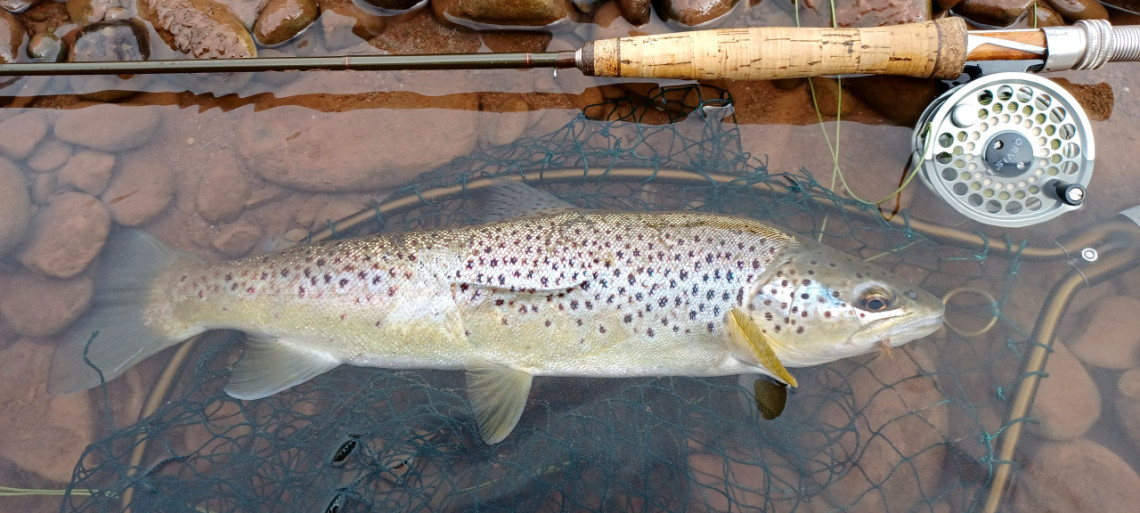 Usk trout on dry fly - SJ of Herefordshire
Usk trout on dry fly - SJ of Herefordshire Thus half-way through March, with the weather still quite wintry at times, we found ourselves with the upper Usk full, but at a fair level for trout fishing, while the lower river was a bit too much for trout but at a reasonable level for salmon. A few Usk salmon anglers were already out, although no fish reported yet. The entire river was running clear although boisterous enough, as you might want and expect for early spring fishing. At the same time the upper and middle part of the Wye showed viable levels for salmon fishing, but the lower river was still very high, with in this case a livid yellow stain to it. On the 16th we had a report of the second Wye salmon capture of the year: a sea-liced 19 pounder taken on a Flying C by Glyn Caute at Lower Carrots and Luggsmouth. “About time too!” people were remarking by then.
MH of Swansea was salmon fishing up at the Rectory, but reported only 4 trout to 17 inches, two of them on a Flying C. HK from Crickhowell with his wife went fishing at Llwyn On Reservoir and they took 8 trout. The third Wye salmon was taken on the 17th by Matt Oliver on the Cafn Stream pool of the Nyth. This was a 16 pounder and apparently another fish had followed the lure shortly before. Matt had a second fish of 18 pounds on the 20th from the neck of the same pool. This was a Sunday of relatively fine, dry weather and Martin Hawes also scored with a 19 pounds cock fish from the Golden Mile on a double-hooked Black and Yellow. Dave Roberts had another fish of 16 pounds taken spinning at Cabalva. And the following day Brian Skinner of Brecon reported a very large fresh fish measuring 41.5 inches taken spinning from Gromaine’s Ferry Pool (in front of the house). It did seem that Wye salmon fishing was starting to fire on more than one cylinder at last, although nothing was yet reported from the Usk.
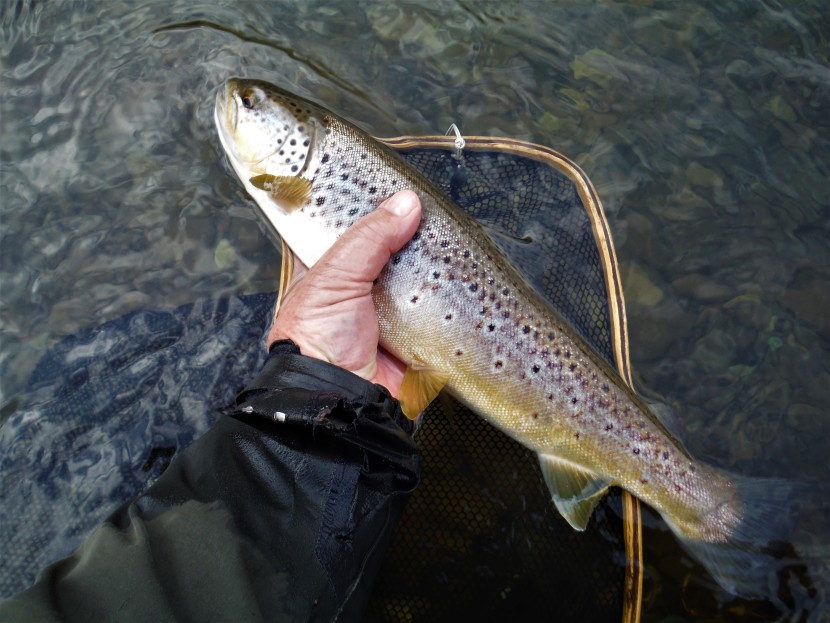 Caught on spiders during a large dark olive hatch
Caught on spiders during a large dark olive hatch 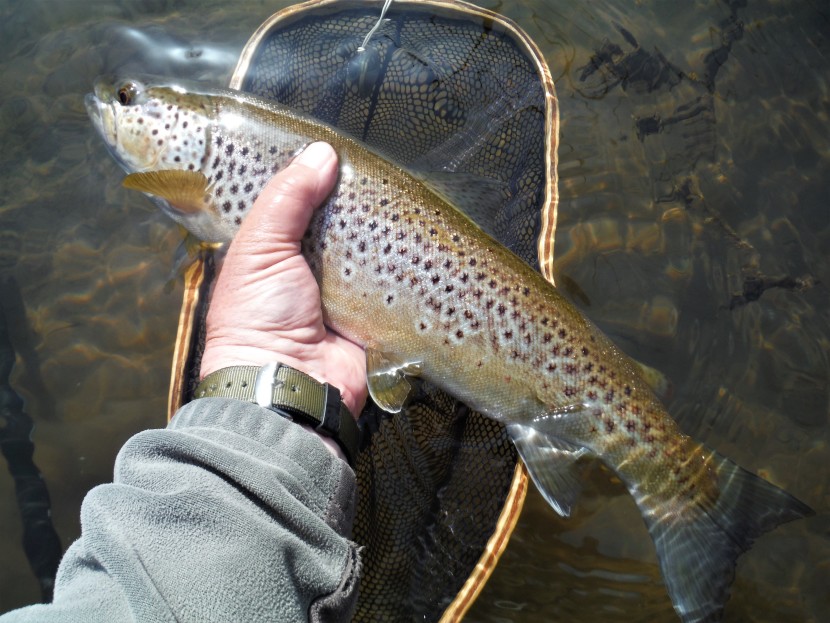 March brown feeder - lower Usk
March brown feeder - lower Usk 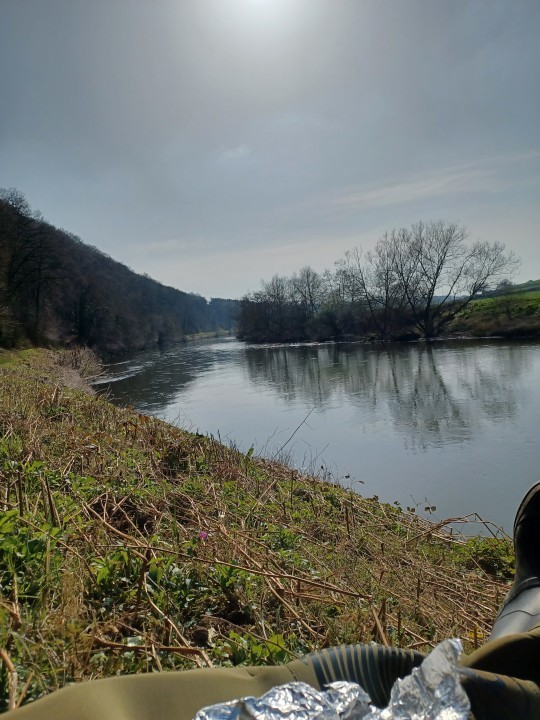 Dean and Chapter Pool - AD from Lyme Regis
Dean and Chapter Pool - AD from Lyme Regis On the 21st IS from Beddau was another who reported a big catch from Llwyn On Reservoir, this time with 30 trout for the day. The high pressure was getting settled now, and although nights were cold, sometimes with a ground frost, they were followed by big temperature swings and bright sunshine with midday temperatures in the high teens. This is not absolutely ideal fishing weather – softer days are preferred by most of us – but at least spring was now coming on with a rush, and new green leaves and blossom were appearing in the lower Usk valley. I still thought AB from Bath was being a bit optimistic when he complained of no fish seen when he fished the Upper Grwyne Fawr beat. 22nd March is just too early for a small stream at that altitude, I would think. The lower beat might have produced with luck.
We pressed on with the trout fishing on the Usk and just about everybody reported March browns hatching during the middle of the day, often with a few olives mixed in also. IG from Pontypridd with two friends had 9 trout from the Usk’s Abergavenny Town Water on the 23rd, catching them on dry flies during a midday hatch. Next day GS from Exeter with a friend had a good visit to the Dinas fishery upstream, taking a dozen between them, again during a March brown hatch. IP from London had a memorable day next door at Abercynrig, taking 6 trout to a very impressive 3 pounds, yet again while the March browns were hatching. But oh IP, I have to take issue with your photograph of the big one! How could you! Is that a Hardy Model Perfect reel I see there which has somehow got half buried in wet sand during the excitement of the capture? Please tell me that you took it to pieces to clean it out and re-grease it as soon as you got home!
Meanwhile AD from Lyme Regis fished the Wye’s famous Dean and Chapter Pool below Hereford using a fast sink tip and a Posh Tosh tube and got himself a 94 cm salmon. 94 cm is 37 inches which is probably around 20 pounds given the fish’s apparent condition. I’m pretty jealous; after such an event in such a place on a day of early spring, one might well feel ready to die and go to heaven. I gather AD sat down to drink in the scene and photographed the pool when it was all over.
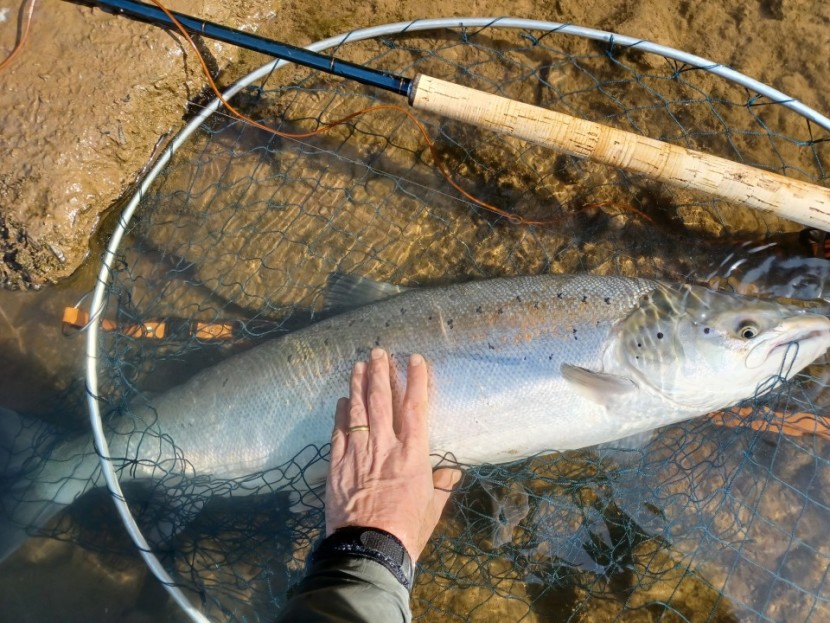 Salmon from the Dean and Chapter - AD from Lyme Regis
Salmon from the Dean and Chapter - AD from Lyme Regis 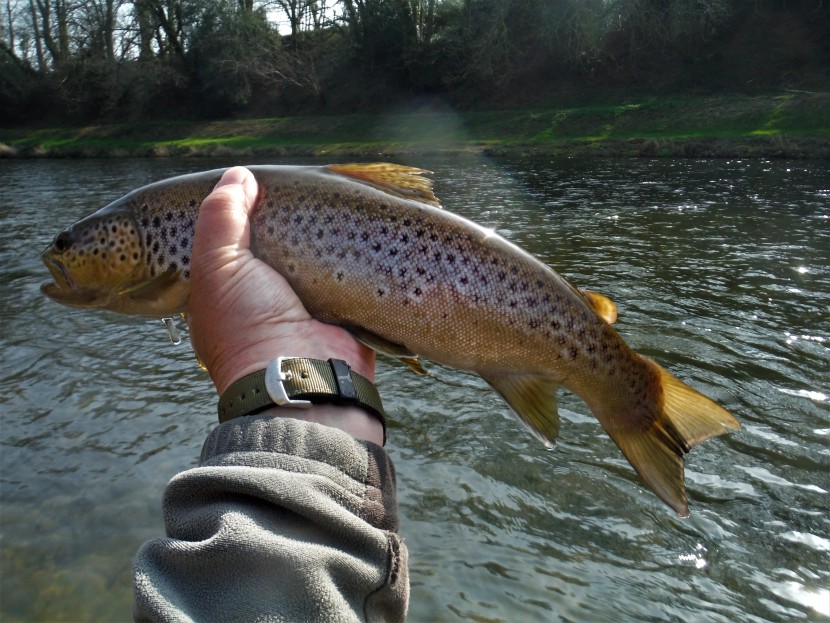 On the dry fly in March
On the dry fly in March The 25th was a good fishing day for many. PM from Oxford had half a dozen trout from the Glanusk Estate on spiders; MH from Swansea had 7 from the Rectory; TB from Worcester had 9 from Penpont, this time during a good large dark olive hatch. Ricky Reno had a mid-teens salmon from Garnons with a Flying C. SJ from Bridgend, however, was disappointed with his blank day at Llwyn On Reservoir, remarking: “What a total waist of money.” I suppose that a chest of money would have been better? Sorry – bad joke.
PM from Oxford was out on Dinas the following day and accounted for another half dozen, mostly on dries. ST from Salisbury had 8 from the same beat. JJ from Neath with a friend had just a brace from Llyn Teifi, but one of them weighed 2.5 pounds. That’s a very large trout from a mountain lake. On the 27th Seth Johnson-Marshall from the Foundation while fishing a private upper / middle Usk beat had another very good day, taking 5 trout to 2 pounds 15 ounces. See the photographs for the quality of these fish. His wife lost a giant trout during the same session. Wyesham reported a small 8 pounds salmon with seal bites.
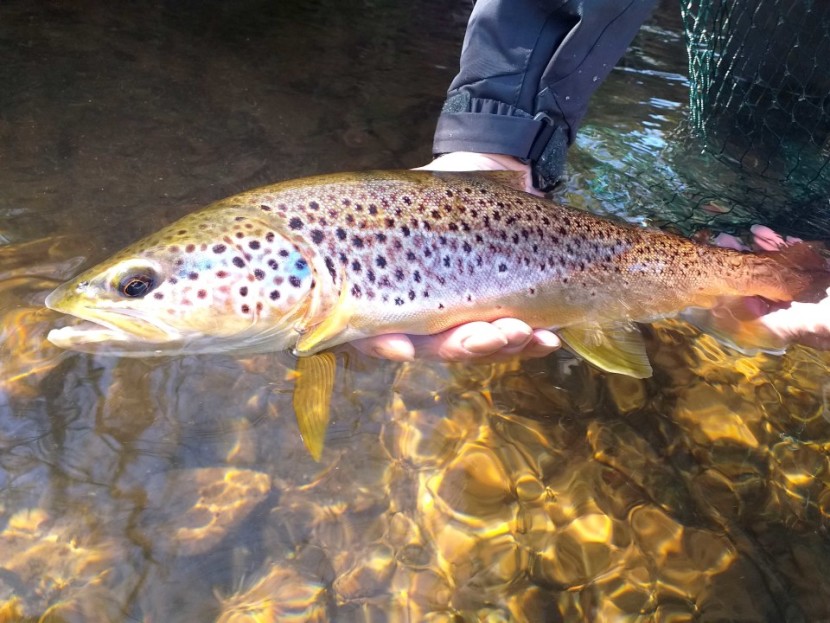 Usk gold - SJ from Herefordshire
Usk gold - SJ from Herefordshire 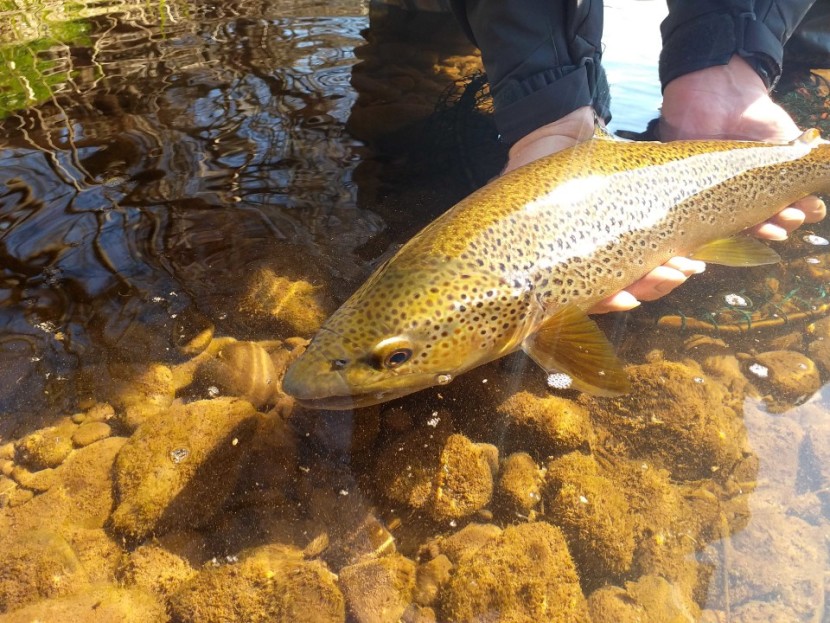 Usk brown trout - SJ from Herefordshire
Usk brown trout - SJ from Herefordshire Also on the 27th KS from Cardiff had a bad day on Llwyn On which he reported by using one very short and one very long sentence: “Nothing. Don’t waste your money they don’t put any fish in just taking money I scanned the whole reservoir with Sonar and not a single fish in there.” Well now! A couple of days later SS from Caerphilly with friends and MR from Bargoed with friends came to Llwyn On and caught 7 trout between them. I did think to myself that it’s a pity that SS and MR didn’t have Sonar, because if they had it they would have known that the trout they caught weren’t there.
About this time SM from the Forest of Dean was disturbed by noisy motor-cyclists around Llyn Syfydrin in the mountains around Aberystwyth and was minded to report them to the police – I’m not sure whether he did? It might pay to be a little cautious about this matter as there are so-called “green lanes” which do allow motor vehicle use off-road in parts of central Wales. Aberystwyth Angling Association who have the fishing on the lake should know the situation.
Finally GO from Brecon hooked a mid-teens salmon in the Rectory Pool at Llyswen, but was unlucky enough to lose it at the net. As the month ended, an icy north-east wind almost returned us to the conditions of winter and slowed fishing action. According to the best figures I can find, we have had just 10 March salmon, which accords with the rather disappointing spring results of other recent years on the Wye. Some of these were superb fish of course, so it’s a case of nice work if you can get it!
Nothing reported yet from the Usk as far as I know. We did have some really interesting trout fishing on the Usk, with plenty of midday olives and March browns again this year and the grannom sedge beginning to show by the end of the month. I think we have everything to hope for during April.
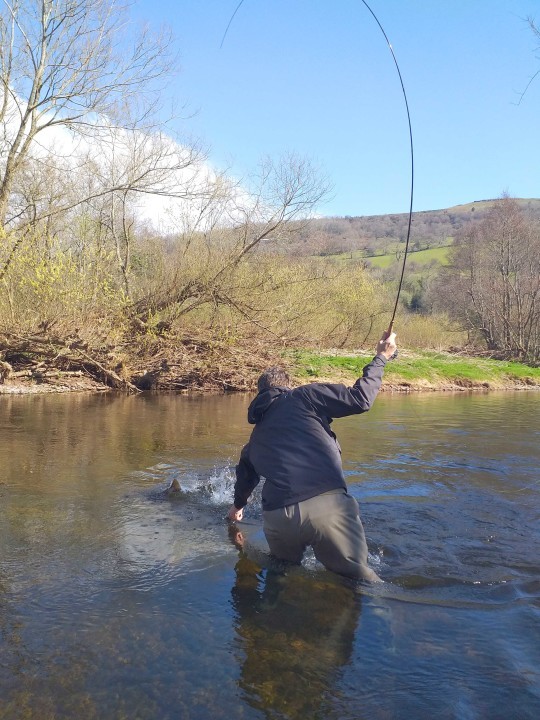 Moment of truth - SJ from Herefordshire
Moment of truth - SJ from Herefordshire 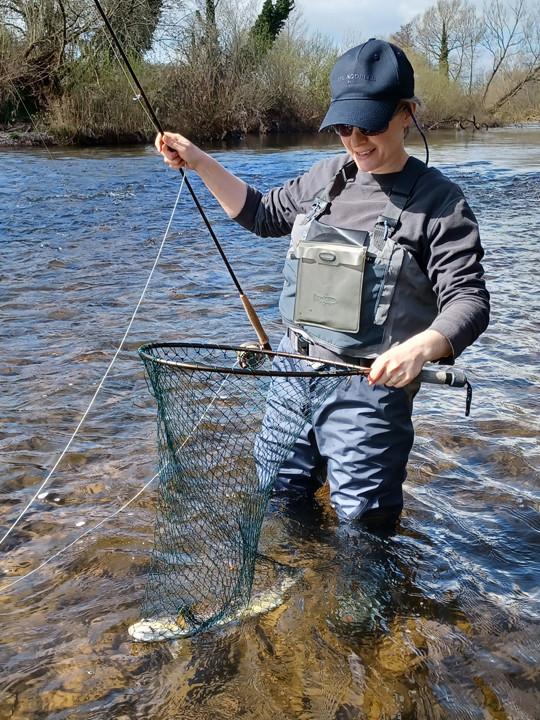 First ever Usk trout - PG from Herefordshire
First ever Usk trout - PG from Herefordshire The latest newsletter from the WUF carries an interesting article about the effect of rainfall and flooding on our catchments. The main point of it is that while we are seeing an increased frequency of really high floods, the sort of dramatic events which used to be separated by decades, but now occur almost annually, measurements tell us that the rainfall itself has not been exceptionally high. The inevitable conclusion is that what has changed is the absorption capacity of the land in the catchment. This change has been going on for a very long time, probably beginning with the adoption of field drainage systems as far back as the 18th century. From that time forward, rather than soaking into the sponge of upland pastures and bogs, rainfall began to arrive and drain off our land more quickly. Even such early angling writers as William Scrope and Lord Edward Grey were already noticing the change and that the floods of the 19th century, when they came, were shorter and steeper than previously, resulting in fewer good salmon fishing days. I liked the analogy of an old-fashioned thatched roof, which after rainfall would drip water for a long time, compared to what was then considered a modern slate roof, which would shed its water and be dry again in half an hour.
The existence of forests and peat bogs, drained or otherwise, have always had a big effect on the catchment’s discharge of water. In less fortunate parts of the world, desert landscapes, being rocky and treeless, are notorious for flash floods which, while rare due to the lack of rainfall, are devastating when they occur. We are also beginning to understand in Britain today that one man’s emergency drainage scheme may achieve nothing more than exacerbating and accelerating his downstream neighbour’s flood. Meanwhile increased use of heavy agricultural machinery and high densities of livestock are compacting the soil and reducing its ability to hold water. What we want, both for wild life and human security, is for our land to be an effective sponge, and to release rainfall slowly and steadily We are beginning to appreciate these factors, but as always with today’s environment, more political will than is currently apparent may be required to reverse the damage.
It had to go, although it was a sad moment for our family. On a frosty morning, the last sight we had of the blue Landrover Station Wagon which I bought new in 1987 was sitting on a trailer behind Leominster Car Auctions’ collection truck as it disappeared round the corner. Back in the autumn, Nick, my trusty long-time Landrover man, having completed its annual service handed me a new MOT certificate. But then he said: “I’m not sure we are going to get this one through the MOT next year. That frame is getting rusty in a lot of places. It’s going to need a rebuild on a new chassis.”
We had known this was coming for a while. 230,000 miles were on the clock although the old truck was mechanically pretty good and almost all original. Fuel and oil consumption were the same as always. Rust was the problem. People who don’t really know sometimes imagine that, because Landrovers have some aluminium panels, they can be left out in the rain forever and take no harm. Unfortunately it isn’t so; the main frame is quite massive, but does eventually rust and the front bulkhead and other steel parts suffer similarly. Most of the really old Landrovers you see around have been rebuilt on new frames at least once. In the long term you are likely to get your money back, but the rebuild itself is a costly and very time consuming business. I told Nick truthfully that I was too old and too busy to be messing round with cars much again; Nick looked thoughtful and reckoned that he might be prepared to have a go at it. A new chassis costs around 3,000 pounds. The rest of it would be very hard to estimate, because who knows which bits would break when taking it all apart? I had a quiet thought myself and privately considered the circumstance that Nick is as old as I am. It struck me the future for both of us looked slightly less certain than a few years ago. The final conclusion was that after 35 years the old girl would have to be sold, as a project for somebody else to undertake.
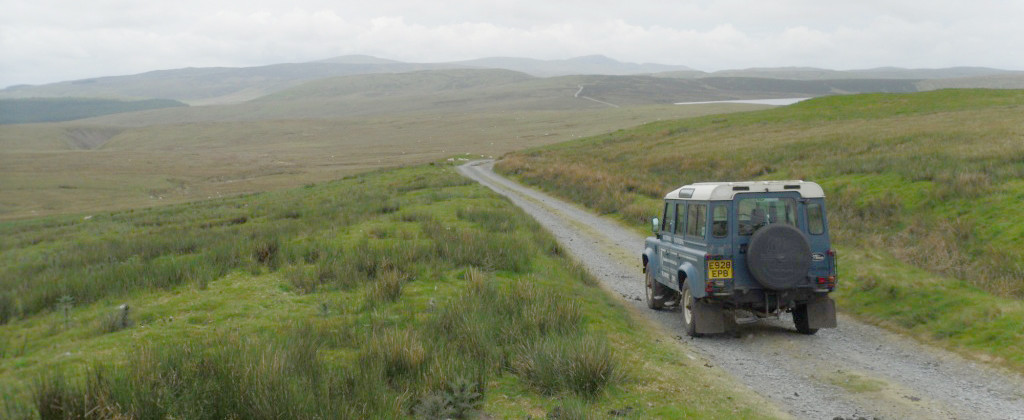 Landover on the road to Bugeilyn
Landover on the road to Bugeilyn I have used quite a few 4WDs for work over the years, including a couple of Discoveries which I just about destroyed in post-war Bosnia. Awful things happened to their elegant blue paintwork. They were originally intended for diplomats and had CD plates but we used them to re-open overgrown tracks leading into burned out communities prior to return of the population. These cars were pushed into difficult places; the short wheel base making it possible to turn on narrow mountain roads and a satellite phone in a dome on the roof were plus points for the Discos. To my delight they would go with ease into places quite inaccessible to US Army Humvees. Before that, during wartime, Landrover Defenders also served us well in an environment where we commonly lost half the fleet to road traffic accidents over the winter. The exception was an armoured Defender brought in by a journalist which I once drove, finding its 3.5 tons almost uncontrollable on ice, with or without chains. Thankfully it was sent back to the UK as no longer required in theatre. UNHCR’s Nissan Patrols were very reliable too, although thirsty on diesel, and Toyota Landcruisers still serve the humanitarian community well all over the world. I never much liked the Toyota Hi-Luxes, preferred transport of the Afghan Taliban who used to load them up with a dozen fighters armed to the teeth. The trouble with the Hi-Luxe was that the driving position is semi-reclining thus restricting the view over the bonnet, so that coming to the peak of a steep desert ridge, you had to get out to see what lay on the other side. I have to admit there are things which wear out on Landrovers which can make them an expensive choice, but they don’t usually let you down in the bush. It’s funny how fond of them you get, noisy and rather slow on the motorway as they are and with the aerodynamics of a brick, but then capable of bounding up a rough track in low gear like a scalded cat.
There were a few tricky moments. Once, in a convoy from Sarajevo to Gorazde, I was driving a company Defender when a dead short occurred in the battery. The radio and all the electrics suddenly died and smoke began to appear from the battery box under my wife’s seat. The convoy was commanded by a French officer but escorted by Italian Bersaglieri, friendly fellows with black ostrich plumes on their helmets. At the time we were held up at the notoriously unfriendly Serb checkpoint at Rogatica, but I knew the convoy was not in a position to wait for us when clearance to move was given. Waiting alone in Rogatica with one of us a Bosnian Muslim and a dead vehicle was not an option, so if necessary we would have abandoned the car and hopped into an APC with the Italians. But – what a great blessing – the Landrover was a diesel, didn’t need electrics, and so just kept on running. I took care not to stall it until we reached our warehouse on friendly territory in Gorazde and the company sent me a new battery on the next convoy.
I have numerous memories, though, of life with my own 110 Station Wagon as this long wheel base Defender model used to be called. It was big enough to sleep in or if needed to carry tents for a family. Some of those memories now come jostling for attention. Parked above the River Tajo at Toledo while we engaged in fishing for wild river carp with floating crust. Earlier we had visited El Greco’s marvellous Burial of Count Orgaz in the Church of Santo Tome. Driving round the Gibraltar one-way system in blazing summer heat. A lively musical evening in a Bavarian gasthof full of revellers in lederhosen, badger bristle hats and hunting jackets. Crossing pine-forested mountains one sunny winter morning to Metsovo, where old men wearing pom-pom shoes and fustanella kilts sat in the sun talking Greek politics. One fine spring day, sitting outside a taverna near the modern town of Sparta waiting for lunch. The Landrover was in the background and beyond that the Taygetos Mountains were still white with snow. The first green shoots were showing on the vine arbour above our heads. We had a village salad on the table and a fresh loaf of bread with a misted copper jug which had been just filled in the cellar with a slightly resinated, straw coloured wine. I can taste it now. There was a smell of meat grilling on charcoal as our lunch was prepared inside. On that particular day, life and southern Greece seemed about perfect.
Driving over Mount Igman in thick snow on the way into Sarajevo past the forlorn relics of the 1984 Winter Olympics. This was early in the Bosnian war and life then seemed less than perfect, worrying in fact, but the fact that a British Library reader’s card with my photo on it got me through a military police checkpoint brought a wry smile to my face (the guard actually looked at it upside down before the horse and cart bringing their rations up the snow-covered track distracted his attention). Another time in 1993 the car had been left for security overnight in the guarded compound of the Franciscan Monastery at Mostar, only to find in the morning that soldiers were clustered behind the corner of the church. This was because a sniper had been working from the windows of a tall building overlooking us from just across the Boulevarde. The café on the corner was on fire. “If you want your car, you can go and get it” was the general message. A lack of imagination and avoiding over-thinking the situation helps at such times, but it was a long trip across the yard to the Landrover and a long wait for the heater plugs to fire up the diesel. The marksman, I presume, had gone for breakfast. He might well have been someone known to me.
Then later there were all those lovely and peaceful fishing days in the UK, at Goodrich Court where the Landrover was parked in the fields year after year, Bigsweir, Aramstone, Cefnllysgwynne on the Irfon, up in the clouds on the moors at Llyn Bugeilyn, the beautiful Stinchar in Scotland and so many other places and rivers. Sometimes I used to take it sea trout fishing, as a back-up in case of running out of energy and being too tired to drive home in the early hours. I remember one night on the Welsh Loughor at Ammanford when I knew that heavy rain was due. It was pitchy dark and about two in the morning when I cast a surface lure armed with a trailing treble across a wide holding pool of dead water. Suddenly there came a loud splash and then a tremendous wrench at the rod. But despite the force of the take, the fish was not on. I tried again and the wrenching take came once more after which the line was again slack. At that point the rain began, slowly at first, but then in torrents. The pool now seemed dead and nothing touched the lure. Dispirited and suddenly very tired, I retreated to the Landrover which I had parked in a bankside wood, leaned the rod against it to be taken down in the morning, crawled in the back, shucked the waders and so into my sleeping bag where I fell asleep. In the grey light of dawn I emerged, thinking to fire up my little cooker and make some bacon and eggs. When I looked at my rod I saw that two prongs of the treble hook on the surface lure, a device called a Towy Intruder, had been opened out straight. I had tied my fly with a hook too fine in the wire for fish like these! Ah well, I wouldn’t make that mistake again. It’s the ones you miss that you remember. I still wonder what monsters might have appeared from the Loughor on that dark night?
So much for Landrovers and the things you can do with them. Hopefully the new purchaser, once the restoration is done, will have some of the fun with it which we did.
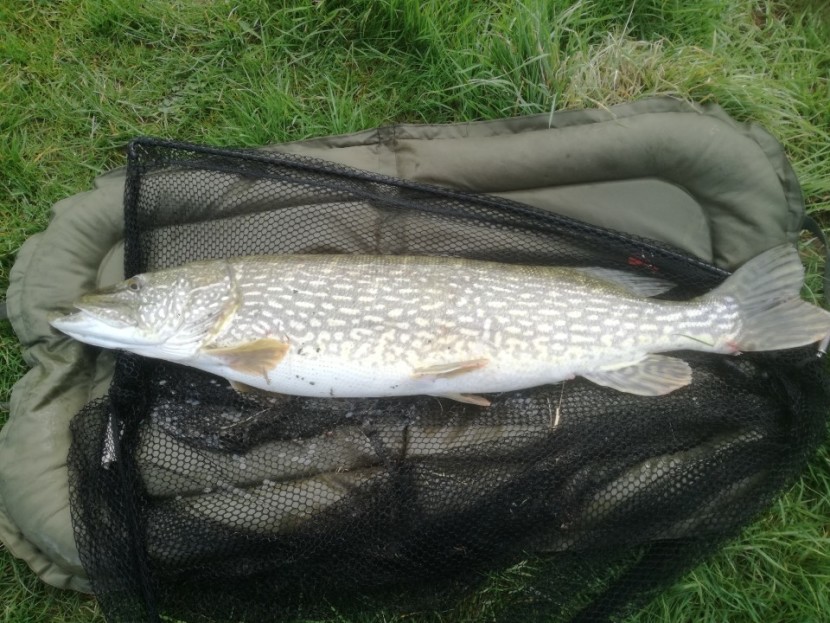 20 pounds plus pike in beautiful condition - PC from Bristol, Sugwas Court
20 pounds plus pike in beautiful condition - PC from Bristol, Sugwas Court 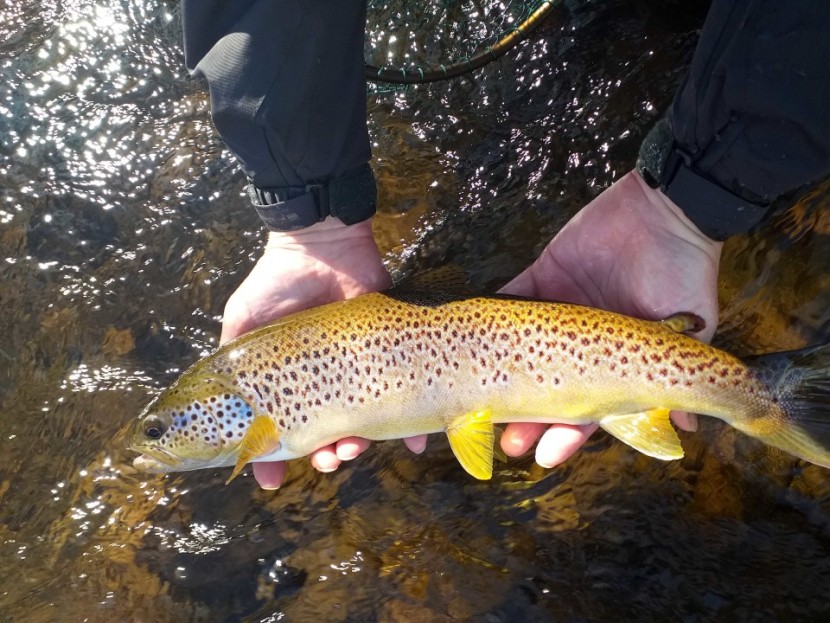 Usk leopard - SJ from Herefordshire
Usk leopard - SJ from Herefordshire Congratulations to Nazanin Zaghari-Ratcliffe, Anousheh Ashoori and their families. Who wasn’t delighted to see that little girl have her mother restored? I found myself wondering exactly at what point during the evacuation journey the released hostages truly felt they could relax and knew for sure that there would be no more games of cat and mouse played by the state authorities? Only on actually leaving Iranian airspace, I would wager. It’s perfectly possible – and it has happened to me – to have a security man come and check you in your seat even when the aircraft is running its engines and waiting in line for take-off. My own journeys to the rather dispiriting land of the chelo kebab and that awful alcohol-free beer tended to occur when there was a problem in a neighbouring country, either Afghanistan or Iraq, and involved a lot of waiting around in hotels while trying to make humanitarian arrangements with the Iranian national authorities. The obvious official contact was a government agency called BAFIA, or more forbiddingly: Bureau for Aliens, Foreign and Immigrant Affairs. Visits to the Foreign Ministry or the Police were much more difficult and the result depended very much on whether you managed to get the ear of the right faction out of a choice of several in that particular agency.
I remember I was in Iran when President Bush made his famous “Axis of Evil” speech, and believe me, everybody I met including taxi drivers and strangers on internal flights wanted me to explain exactly what he had meant by that. Useless to protest that I was an Englishman with no responsibility for this American president. Following the 19th and 20th century imperial experience, there is a tendency in Iran to think that the British are responsible for every bad thing: “Knock your foot against a stone in the desert and you can bet that an Englishman put it there!” Swiss Air was the main haulier running international flights in and out of Tehran in those days and the majority of the travelling customers were Anglo-Iranians. The Swiss company, being in the way of their nation very correct, took care not to infringe Iranian rules. Thus you would hear over the speakers: “We are approaching Iranian airspace; no more alcoholic drinks will be served.” A last gulp of gin and tonic for the ladies and on would go the chador hijabs. On the way out, the ritual was reversed; Iranian airspace left behind, the chadors were off, and the cabin crew could not serve gin and tonics fast enough.
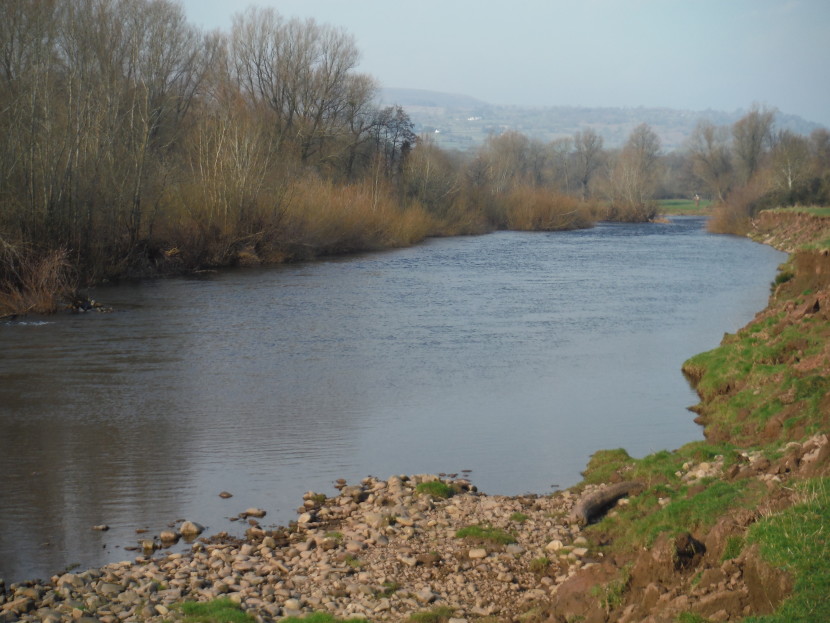 Middle Usk in spring
Middle Usk in spring 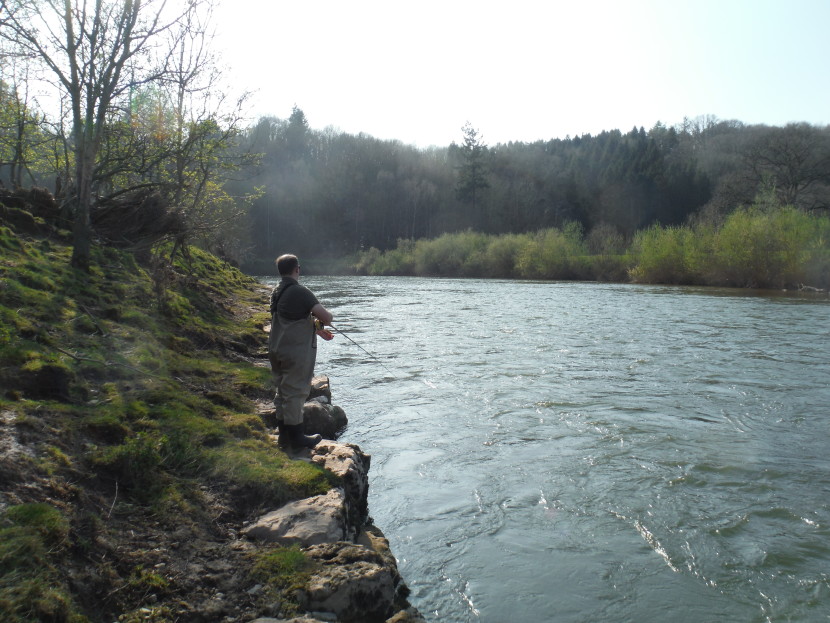 Goodrich Court - fishing the Maddox
Goodrich Court - fishing the Maddox Russia’s war machine continues to grind into Ukraine. It has been criticised for grinding slowly, but it is still grinding. Only a month ago I was shocked to note that the number of refugees had passed 300,000. By 21st March, just 3 weeks into the war, UNHCR estimated the total number of displaced Ukrainians, both internally and externally, at more than 10 million. Many European nations have reacted with efficiency and compassion. These certainly include Poland and Hungary whose populations recognize genuine refugees when they see them and particularly, I will be churlish enough to remark, if they are white and Catholic. Meanwhile we are in that infamous fog of war and with a lack of embedded reporters it’s very difficult to get hard information from both sides about the military situation, including the casualty figures. Instead we tend to get interpretations from pundits and journalists behind the lines and there is no shortage of claims, counter-claims and rumours. I would also like to sift through news sources myself to assess to what extent they are or are not putting out propaganda, rather than having it done for me. RT has been shut down by the UK, which sits ill with this country’s tradition of freedom of speech. You can still get to TASS if you want to know what the Russians are saying. There is plenty of other work for journalists to be doing and there are many unanswered questions. I would like to know more about the situation of minorities, including ethnic Russians in Ukrainian majority areas, Crimean Tartars etc. What conditions are prisoners of war or those suspected of espionage being kept in and does the International Red Cross have access to them? In an area with a long and sad reputation for corruption and the trafficking of women, what is organised crime doing now and are the displaced protected?
At the moment it is very difficult to predict how this might end or how long it might take. For one thing, the pundits are arguing about what Putin’s war aims actually are, although he has consistently demanded a demilitarised, neutral Ukraine, outside NATO, with self-determination for majority ethnic Russian areas. The attraction of the Black Sea ports is obvious. Might he decide to help himself to Odessa also? After all the death and destruction what a tragic irony it will be for Ukraine if, when Zelensky agrees peace terms in the end, he has to settle for what Putin has been asking for all along?
My favourite principled stand of the month – and I’m afraid I have lost the name of the gentleman concerned – was that of one of the contracted shipping workers bussed in to take the place of the sacked P&O ferry crews. The bus was parked on the dock within sight of the regular crew members about to be turned off their ship when he took his decision. “I realised that, you know, I would have to look this man in the mirror tomorrow morning. So I got off the bus.”
Tight lines for the April fishing!
Oliver Burch